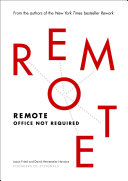

Remote work is not just a trend but a fundamental shift in how work is conducted. The authors argue that technology has advanced to a point where remote work is not only feasible but can also enhance productivity and job satisfaction. They discuss how companies can leverage tools such as video conferencing, instant messaging, and project management software to facilitate communication and collaboration among remote teams. The book emphasizes that the ability to work from anywhere opens up a global talent pool, allowing organizations to hire the best talent regardless of geographical constraints. This shift challenges traditional notions of the workplace, where employees are expected to be physically present in an office, and highlights the need for businesses to adapt to this new reality.
Continue readingOne of the central themes of the book is the importance of trust and autonomy in a remote work environment. The authors argue that micromanagement is counterproductive and that companies should empower employees to take ownership of their work. By fostering a culture of trust, organizations can encourage employees to be more accountable and engaged in their tasks. The book provides insights into how leaders can build trust within remote teams, including setting clear expectations, providing necessary resources, and encouraging open communication. The authors contend that when employees feel trusted and autonomous, they are more likely to be motivated and productive.
Continue readingEffective communication is paramount in a remote work setting. The authors stress that clear and consistent communication helps to bridge the gap created by physical distance. They provide strategies for maintaining strong communication channels, including regular check-ins, using various communication tools, and establishing norms for responsiveness. The book highlights the importance of not only conveying information but also fostering relationships among team members. The authors suggest that remote teams should prioritize informal interactions, such as virtual coffee breaks, to strengthen connections and build camaraderie.
Continue readingCompany culture plays a crucial role in the success of remote work arrangements. The authors argue that organizations must actively cultivate a strong culture that transcends physical boundaries. This includes defining core values, promoting inclusivity, and celebrating achievements, even in a virtual environment. The book discusses how remote teams can create a sense of belonging and community through virtual events, recognition programs, and collaborative projects. By investing in culture, companies can enhance employee engagement and retention, which are vital for long-term success.
Continue readingRemote work offers significant advantages in terms of work-life balance and flexibility. The authors explore how employees can better manage their time and responsibilities when they are not tied to a traditional office schedule. They discuss the importance of setting boundaries to avoid burnout and the role of technology in enabling flexible work hours. The book encourages readers to adopt a mindset that values results over hours worked, promoting a healthier approach to productivity. By allowing employees to tailor their work schedules to their personal lives, organizations can foster a more satisfied and productive workforce.
Continue readingThe book provides a comprehensive overview of the tools and technologies that facilitate remote work. The authors discuss various software solutions for project management, communication, and collaboration that can enhance productivity. They emphasize the need for organizations to invest in the right technology to support their remote teams effectively. The book also addresses the challenges of technology overload and the importance of selecting tools that align with the team's workflow and needs. By leveraging the right technology, companies can streamline processes and improve overall efficiency.
Continue readingHiring and managing remote teams presents unique challenges and opportunities. The authors provide guidance on how to identify candidates who are well-suited for remote work, including traits such as self-motivation, communication skills, and adaptability. They also discuss the importance of creating an inclusive hiring process that considers diverse backgrounds and experiences. Additionally, the book offers strategies for managing remote teams effectively, including setting clear goals, providing ongoing feedback, and fostering professional development. By implementing these practices, organizations can build high-performing remote teams that contribute to their success.
Continue reading